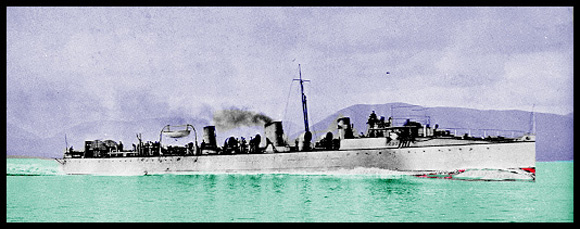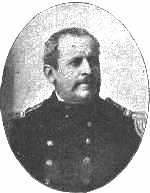


The TERROR later sailed on her own to San Juan, Puerto Rico. At 1:30 pm, June 22, 1898, she sortied from San Juan and attacked the blockading Auxillery Cruiser USS ST. PAUL. The Spanish vessel was severely damaged by the ST. PAUL's fire and had to be beached. She was repaired in San Juan and left for Spain on September 14, 1898, after the end of hostilities.
FUROR and PLUTON, under the personal command of Capitán de
Navio Villaamil, were the last two vessels out of Santiago Harbor on July
3, 1898. The Torpedo Boat Destroyers soon came under heavy attack by the
Armed Yacht USS GLOUCESTER, under the former
First Officer of USS MAINE, Lt. Commander Richard
Wainwright, the Battleships INDIANA and IOWA
and, a little later, the Armored Cruiser NEW YORK.
Both Spanish vessels were soon riddled, the FUROR plunging to the bottom
and the PLUTON being run up on some rocks and later exploding. The heroism
of the Spanish sailors, and of those on the unarmored and lightly armed
GLOUCESTER, provoked much comment from US Naval personal and correspondents.
Capitán de Navio Fernando Villaamil went down with the FUROR.


| Classification: | Torpedo Boat Destroyers | |
|---|---|---|
| Completed: | 1896-97 | |
| Armament: | Six Rapid-fire guns | |
| Two torpedo lauchers | ||
| Length: | 220 feet | |
| Displacement: | Furor and Terror, 370 tons, | |
| Pluton, 400 tons. | ||
| Speed: | 26 knots |

Brown, Charles H., "The Correspondent's War", New York: Charles Scribner's Sons, 1967.
Freidel, Frank, "The Splendid Little War", Boston: Little, Brown and Company, 1958.
González López, Manuel P., Personal Internet Contact.
Iborra, Federico, (image of Vazquez).
Jane, Fred D., "Janes All the World's Fighting Ships, 1898", New York: Arco Publishing Co., Inc, 1969.
Rivero, Captain Angel, "Crónica de la Guerra Hispanoamericana en Puerto Rico", Editorial Edil, Inc., Rio Piedras, Puerto Rico, 1972 (reprint, first published 1921). Thanks to Ramiro Cruz.

